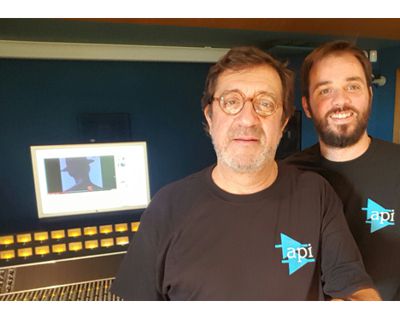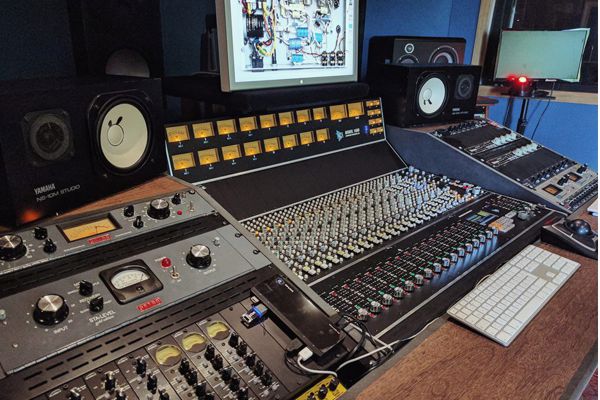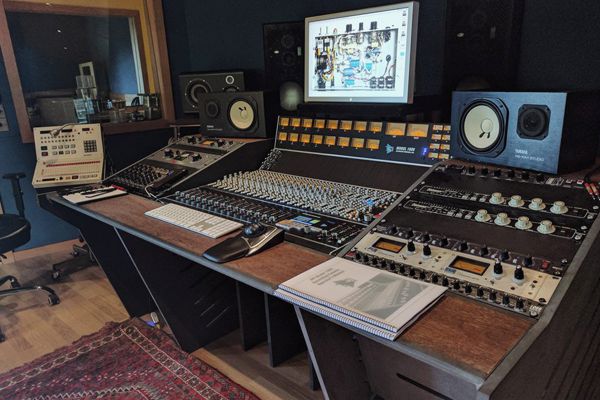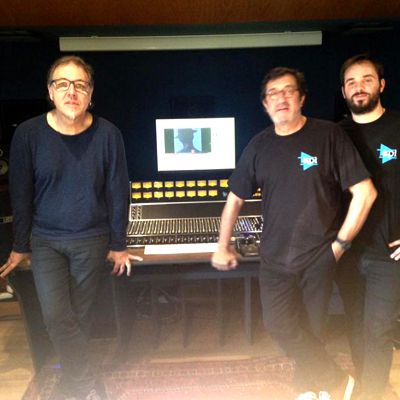 The studio Vale de Lobos is located in a small farm, in a place with the same name, very close to beautiful Sintra, not far from Lisbon. Rui Veloso is a Portuguese musician enormously recognized for his contribution to the great expansion of the so-called “Portuguese Rock” in the early 80’s. His album “Ar de Rock” is one of the best selling and sounded albums ever in the country. But besides that, Rui has published a number of albums that have been awarded Platinum or Gold and has collaborated with people like Nuno Bettencourt (from Extreme), Brazilians Paralamas do Sucesso, Luz Casal, Sara Tavares or BB King himself.
The studio Vale de Lobos is located in a small farm, in a place with the same name, very close to beautiful Sintra, not far from Lisbon. Rui Veloso is a Portuguese musician enormously recognized for his contribution to the great expansion of the so-called “Portuguese Rock” in the early 80’s. His album “Ar de Rock” is one of the best selling and sounded albums ever in the country. But besides that, Rui has published a number of albums that have been awarded Platinum or Gold and has collaborated with people like Nuno Bettencourt (from Extreme), Brazilians Paralamas do Sucesso, Luz Casal, Sara Tavares or BB King himself.
–
In 1995, Rui Veloso built his private studio, which, in addition to recording all his works, since then, is also a space sought by an infinity of other Portuguese and foreign artists. This studio is composed of 4 recording rooms with different characteristics, one of them dedicated to the recording of keyboard instruments and where a Yamaha S4 piano, a Hammond A100, a Wurlitzer, a Fender Rhodes and a few other ‘Vintage’ keyboards. The control, until recently, housed an Otari Elite + console, which now “rests” in the workshop at the back of the building, whilst the intermediate solution found has not been fully satisfactory.
In recent months, Rui and his resident engineer, Pedro Vidal, have been in contact with Reflexion Arts looking forward to a solution for the best option to having a console in his studio once again. The choice fell on the API 1608, automated with P-Mix. The desk arrived in Spain, imported by Funky Junk Spain, the API distributor for the Iberian Peninsula, in mid-November and, two days later, we were installing it in the Vale de Lobos studio.
RA – What happened? All this revolution in the studio ?!
Rui Veloso – Well, we had this old Otari ELITE +, which sounded good and had a bit of everything needed to record and control monitors but consumed an absurd amount of power every month. Because it had to be on 24 hours, 7 days a week, the expense was absurd. And we decided to remove it and replace it with an SSL rack. But it is not the same and there was something missing in the center of the control-room.
 RA – And why did you choose the API? Is it true that you already had experience with the API sound, right?
RA – And why did you choose the API? Is it true that you already had experience with the API sound, right?
–
Pedro Vidal – Aesthetics! No, I’m joking. We already knew the preamps since many years, as there has always been a Lunchbox here with a couple of 512s and also a 3124+ unit. That is why it made sense to have 16 preamps with this quality installed here. It is true that it is an important investment, but to be able to have all these preamps, the various summing buses, the monitor control with alternative outputs, the DAW control and even the EQs that we are going to be adding, all in the same box, is a luxury. It is justified to have a centerpiece of the studio. It is like the brain from where everything is under control.
RA – So it is important for you to have all that control over the process and that is not limited to the control of a mouse and a screen. As you know, that has not been the trend in recent years and many claim that they do everything inside the computer. What is your opinion?
PV – Yes, I know. But first you have to capture the sound sources well and, for that, you have to start with having a good electrical supply, so that all the preamps and all other gear work at full performance and without noise. The dynamics of the preamps also depend on that. The initial signal processing must also be adequate. After entering the Protools you can then decide what to do. There are undoubtedly very good mixes totally produced within the DAW, or hybrid mixes. But for us it is also important to be able to do completely analogue productions, since we have the tape recorder (Otari MTR90) still operative. There are things with few tracks – jazz recordings, for example, that take advantage of that fantastic grand piano that we have in one of the rooms – where you can apply this way of working. It is a plus and it’s a practice that is disappearing.
RA – Do you think that this is cyclical fashion?
PV – Well yes, it’s often fashion, but I think people also realize that when they invest important sums, say ten or fifteen thousand euros, they want to get the return on that investment and what they start to realize is that most pieces of digital technology, in a few years, become unusable, stop being useful and are not worth a penny.
RA – They’re obsolete ?!
PV – Yes, many of those devices, in 5 years, have no value, as they become incompatible with the new operating systems, while this console will continue to sound fantastically, without depending on anything other than its analog connections. In this way its value is never lost. But there is another important issue, which is the fact that in the API 1608 all comes included. When you buy a monitor controller, a DAW controller, enough external preamps, a summing amp, etc., you end up investing a large amount of money and you risk not interfacing everything correctly. You know: impedances, connections… Here everything is concentrated in the same device and, so far as we know, these API guys don’t usually get it wrong.
RA – Very good. Thank you. Enjoy the 1608.
The console was installed in a nice piece of furniture designed and built by Miguel P. Marques. During that afternoon, the API 1608 would have its premiere with a production of guitarist / composer João Gil. That first session has flowed perfectly.
- Oficial Web: www.estudiovaledelobos.com
- Rui Veloso Oficial Web: www.ruiveloso.com.pt




